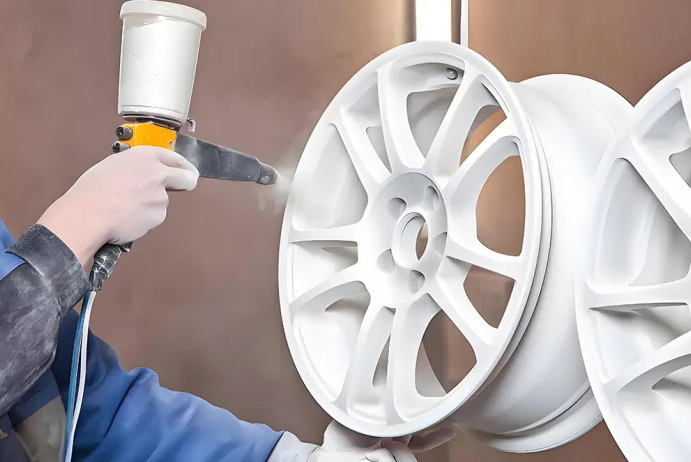Introduction: The Importance of Durable Finishes for Alloy Wheels
Alloy wheels are prized for their lightweight, strength, and aesthetic appeal in the automotive industry. However, their exposed position subjects them to harsh conditions—road salts, brake dust, corrosion, UV rays, and mechanical impacts—that can degrade appearance and performance over time.
Powder coating has emerged as a superior finishing technology that not only enhances visual appeal but significantly extends the lifecycle of OEM alloy wheels. This article explores how powder coatings protect alloy wheels, the technical advantages, and why leading manufacturers rely on this method.
What is Powder Coating?
Powder coating is a dry finishing process where finely ground pigment and resin particles are electrostatically charged and sprayed onto the wheel’s surface. The coated wheel is then cured in an oven, causing the powder to melt, flow, and form a tough, uniform, and highly adherent coating.
Unlike liquid paint, powder coating produces a durable, thick film free of runs or sags, with excellent mechanical and chemical resistance.
How Powder Coatings Protect Alloy Wheels
1. Corrosion Resistance
Aluminum alloys naturally form an oxide layer but are still vulnerable to corrosion, especially in salty or acidic environments. Powder coatings act as a barrier layer preventing moisture, salts, and chemicals from reaching the metal substrate.
This protective shield minimizes pitting, oxidation, and structural degradation, which are common causes of wheel failure.
2. Scratch and Abrasion Resistance
Road debris, curbs, and brake dust can cause surface scratches or wear on alloy wheels. Powder coatings provide a hard, impact-resistant surface that resists scratches and chips, preserving the wheel’s finish and integrity.
3. UV and Weathering Protection
UV rays can cause fading and chalking in traditional paints. Powder coatings contain UV stabilizers that protect against sunlight, ensuring the wheel’s color and gloss remain vibrant over years of exposure.
4. Chemical Resistance
Wheels encounter various chemicals such as oils, gasoline, brake fluids, and cleaning solvents. Powder coatings are chemically inert, resisting stains, discoloration, and breakdown caused by these substances.

| Aspect | Powder Coating | Conventional Liquid Paint |
|---|---|---|
| Durability | High scratch, chip, and chemical resistance | Lower; prone to runs, cracks, and chips |
| Environmental Impact | No volatile organic compounds (VOCs) released | VOCs present, environmental hazard |
| Thickness Control | Uniform, thicker coatings possible | Variable thickness, risk of sagging |
| Finish Quality | Smooth, uniform, glossy or matte finishes | May require multiple coats and drying |
| Efficiency | Faster curing, less waste | Longer drying times, overspray issues |
Advantages Over Conventional Painting
Industry Applications and Case Studies
Automotive OEMs
Major automotive manufacturers increasingly specify powder-coated alloy wheels for their superior lifecycle performance. Powder-coated wheels reduce warranty claims related to corrosion and appearance, enhancing brand reputation.
Aftermarket Wheels
Custom wheel manufacturers use powder coatings to offer durable, customized finishes in various colors and textures, appealing to car enthusiasts who demand both style and longevity.
Motorsports
In racing, wheels face extreme conditions—high temperatures, debris impacts, and frequent cleaning. Powder coatings provide robust protection while maintaining lightweight properties critical for performance.
Technical Considerations for OEM Powder Coating
Surface Preparation
Proper pretreatment is essential for coating adhesion. Steps include:
Cleaning: Removal of oils, dirt, and contaminants.
Chemical conversion coating: Typically chromate or phosphate treatment to enhance corrosion resistance.
Rinsing and drying: To prepare a pristine surface.
Powder Selection
Powders come in various chemistries:
Epoxy powder coatings: Excellent adhesion and chemical resistance but lower UV stability.
Polyester powder coatings: Good weatherability and UV resistance, widely used for wheels.
Hybrid powders: Combine properties of epoxy and polyester for balanced performance.
Application Process
Electrostatic spraying: Powder particles are charged and sprayed onto grounded wheels.
Curing: Wheels are baked at temperatures around 180–200°C for 10–20 minutes.
Proper curing ensures full crosslinking of the powder, delivering optimal durability.
Maintenance Tips to Maximize Powder Coated Wheel Life
Clean regularly with mild soap and water to remove brake dust and grime.
Avoid harsh chemical cleaners or abrasive brushes that may damage the coating.
Inspect periodically for chips or scratches; promptly repair to prevent corrosion.
Use protective waxes or sealants recommended for powder-coated surfaces.
Environmental and Cost Benefits
Powder coating is a more sustainable finishing method due to:
Elimination of solvent-based VOC emissions.
High material utilization efficiency with minimal overspray.
Lower energy consumption with faster curing cycles.
Longer lifecycle reduces replacement frequency and waste.
From a cost perspective, the extended durability means fewer warranty repairs and longer intervals between wheel refinishing or replacement.
Conclusion
Powder coating significantly extends the lifecycle of OEM alloy wheels by providing superior corrosion protection, abrasion resistance, UV stability, and chemical durability. This advanced finishing process not only enhances wheel aesthetics but also contributes to vehicle safety and customer satisfaction.
Manufacturers and consumers alike benefit from powder-coated wheels that maintain their finish and performance even under challenging road conditions.
For industry-leading powder coating solutions that maximize alloy wheel durability and beauty, trust YD Powder Coating—your expert partner in surface protection innovation.








